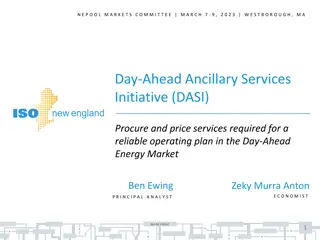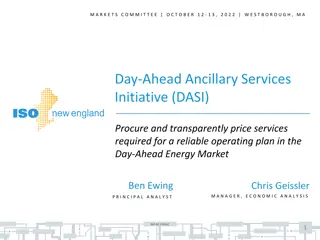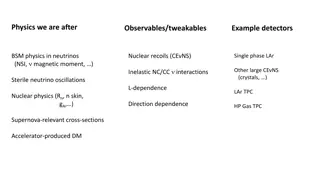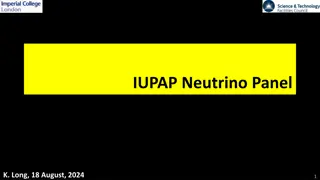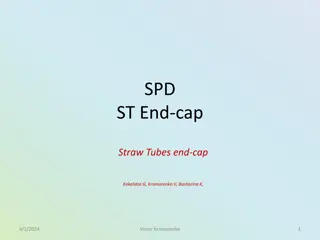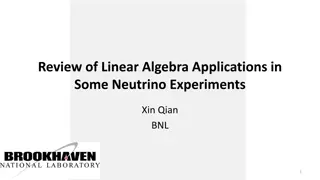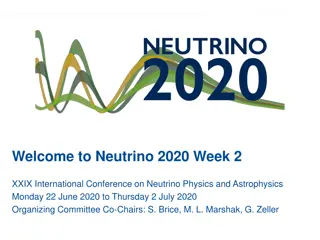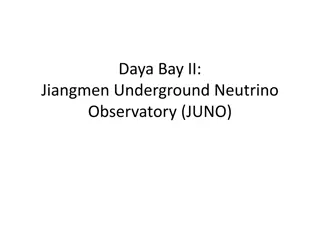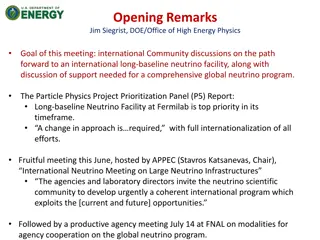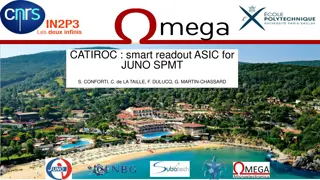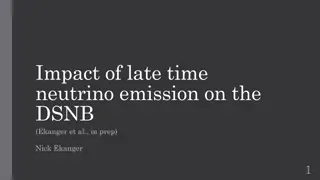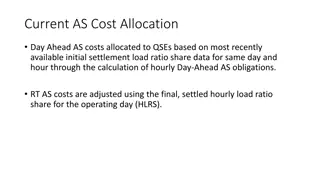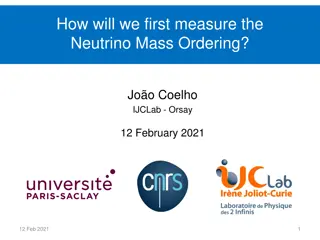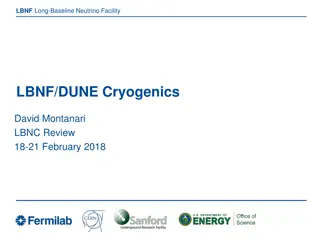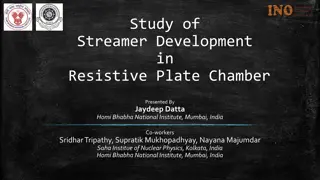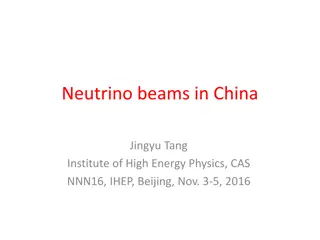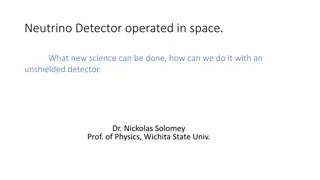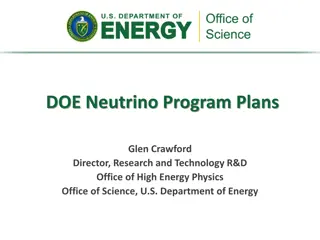Ancillary Structure Analysis for Long-Baseline Neutrino Facility Horn Prototype
The ancillary structure analysis for the Horn A prototype at the Long-Baseline Neutrino Facility involves detailed documentation tracking, FEA projects, and design considerations such as conductor stiffness and spider loading. The analysis approach includes rigorous documentation and peer review processes to ensure the integrity and functionality of the structure.
Download Presentation

Please find below an Image/Link to download the presentation.
The content on the website is provided AS IS for your information and personal use only. It may not be sold, licensed, or shared on other websites without obtaining consent from the author. Download presentation by click this link. If you encounter any issues during the download, it is possible that the publisher has removed the file from their server.
E N D
Presentation Transcript
Long-Baseline Neutrino Facility LBNF Neutrino Beamline Prototype Horn A Final Design Review Ancillary Structure Analysis Cory Crowley / Nnamdi Agbo 27 January 2021
Outline Analysis Approach & Documentation Tracking Significant FEA Projects - Lift Clamps - Water Tank - Pivot Blocks Excel Sheet Calculations - Plateau Loads & Helicoflex Seal Compression - Stripline Features Summary 1/27/21 Cory Crowley | Ancillary Structure Analysis 2 LBNF
Analysis Approach & Documentation Tracking Master excel sheet listing identifies all Horn Systems analysis efforts. Highlighted items applicable to prototype Horn A. Lists author & reviewer(s). Location of analysis work per DUNE/LBNF. Most have ED number in Teamcenter. Nothing should be local to engineer. 1/27/21 Cory Crowley | Ancillary Structure Analysis 3 LBNF
Analysis Approach & Documentation Tracking EM allows graded approach. Individual engineer needs to match complexity of work to amount of documentation. Most FEA work is substantial and receives dedicated ED number and can be found in Teamcenter as required per the EM. Non-critical brackets / mounts / weldments are at discretion of engineer / designer. Peer review correspondence is tracked through email at minimum. All documents found in DUNE-doc-db will still have ED number associated with it for traceability. Teamcenter ED will continue for versioning after project is complete. Release process is group effort / takes time. Any ED not yet released in TC while waiting for checker / approver team has email peer review correspondence to substantiate review completion. 1/27/21 Cory Crowley | Ancillary Structure Analysis 4 LBNF
Horn A Conductor Stiffness / Spider Loading Check PDR recommendation: confirm spider supports have the ability to pull Horn A into straightness tolerance. Horn A profile should not leave welding machine more than .010 out of ideal centerline. Force offsets to pull horn .010 from centerline in ANSYS should be near identical to pull horn .010 back in centerline 2 spiders need 60lb force advantage @ 120 degree azimuth to achieve goal. 285lb available preload is sufficient. 5 1/27/21 Cory Crowley | Ancillary Structure Analysis LBNF
Lift Clamp FEA ED0013019 Special clamps provide coupling surfaces & keyway for remote handling fixture insertion. Identical concept to NuMI. Strengthened concept to handle Horn A weight. 1/27/21 Cory Crowley | Ancillary Structure Analysis 6 LBNF
Lift Clamp FEA ED0013019 Mass is overestimate due to steel dummy target. Don t know target weight, but steel is worst case, so, use worst case. C.G. is known to be close to U.S. clamp, but not past it. Decided to load single clamp with full horn weight for conservative analysis. 1/27/21 Cory Crowley | Ancillary Structure Analysis 7 LBNF
Lift Clamp FEA ED0013019 All stresses are acceptable & well below allowable for yield. Ignored any stiffening contributions from water line clamps. No threads for binding plate shoulder bolts are in shear. 1/27/21 Cory Crowley | Ancillary Structure Analysis 8 LBNF
Lift Clamp FEA ED0013019 Investigation of equivalent stress at binding plate shows concentration where expected. Did not ignore concentration & upgraded material from 304SS to Nitronic 60 to get S.F. above 2 & meet AISC / ASD criteria. Binding plate can be suppressed, and clamp studs will hold load, though deflection increases. Lift clamp deflection as analyzed is acceptable. 1/27/21 Cory Crowley | Ancillary Structure Analysis 9 LBNF
Water Tank FEA Structural: ED0012923 Water tank support system is designed for all horns. Heaviest horn is Horn B (~8500lbs), but worst-case scenario is maximum hydraulic table loading in work cell. 6000lb-force per support table, 1 support table for each end. Need to ensure water tank and Horn do not catastrophically fail during remote handling link-up to support module. 1/27/21 Cory Crowley | Ancillary Structure Analysis 10 LBNF
Water Tank FEA - Structural: ED0012923 1/27/21 Cory Crowley | Ancillary Structure Analysis 11 LBNF
Water Tank FEA Thermal / Structural: ED0013085 PDR comment: Confirm water tank thermal expansion does not cause bellows failure for (furthest) drain line. Internal secondary check: confirm pivot link swing from expansion does not cause excessive moment at U.S. rigid connection. 1/27/21 Cory Crowley | Ancillary Structure Analysis 12 LBNF
Water Tank FEA Thermal / Structural: ED0013085 Applied internal pressure from argon system (2PSIG). Applied 115% EDEP from 1.8M target @ 1.2MW. Applied thermal radiation load from average chase floor & wall temperature assuming form factor of 1 & corroded aluminum (conservative). Exterior tank convective cooling matches standard chase values. Interior cooling provided by water flow from horn. 1/27/21 Cory Crowley | Ancillary Structure Analysis 13 LBNF
Water Tank FEA Thermal / Structural: ED0013085 Determination of Heat Transfer Coefficient on Horn A Water Tank Ejector Flange Water Cup ID (IN) Water Cup ID (M) Area (M^2) Flow Rate (GPM) Flow rate (M^3/s) Flow Velocity (M/s) Prandtl Number (Pr) @ 30C Density of water (kg/M^3) @ 30C Dynamic Viscosity of Water @ 30C Reynolds Number (Re) Thermal Conductivity of Water (k) @ 30C Fanning Friction Factor (f) Nusselt Number (Nu) Heat Transfer Coefficient (h) W/M^2*C 3.125 0.079375 0.004948 44 0.002776 0.560932 5.534 995.7 0.000798 55575.4 0.603 0.005189 328.0652 2492.262 1/27/21 Cory Crowley | Ancillary Structure Analysis 14 LBNF
Water Tank FEA Thermal / Structural: ED0013085 Temperatures not too high Hot spots are not surprising - Main swinging link bracket with no direct contact to water cooled surface. - Stainless swivel foot is hottest @ 71C. 1/27/21 Cory Crowley | Ancillary Structure Analysis 15 LBNF
Water Tank FEA Thermal / Structural: ED0013085 Performed sensitivity studies. - Trial 1: Cut exterior convection 50% (Nitrogen cooling) - Trial 2: Cut Interior convection 50% (water cooling) - Trial 3: Cut all cooling 50% except ejector All reductions had minor effects. 2 Cutting chase cooling had larger effect than interior cooling. Points to thin shell thermal conductivity limitations. 1 3 1/27/21 Cory Crowley | Ancillary Structure Analysis 16 LBNF
Water Tank FEA Thermal / Structural: ED0013085 Conclusion: Pivot link growth and differential tank swing is very low. Links grow .005 from thermal load. Links swing out .024 from tank growth when measuring from rigid base to point B (bracket location). Vendor guidance is 10% offset of 1 live length is acceptable. Even factoring in rare thermal event where conductors are immediately cooled and tank remains hot, D.S. bellows @ point C have 3X allowable flexibility before surpassing guidelines. 1/27/21 Cory Crowley | Ancillary Structure Analysis 17 LBNF
Pivot Block FEA - ED0012923 Pivot blocks are primary structural attachments that link the conductor package to the support hangers & module. They must take full horn weight, target weight, target utility lines, and stripline offset reaction force for vertical displacement. They can ignore all horn utility line weights, as those are carried by the utility beams and link back to module mounts. 1/27/21 Cory Crowley | Ancillary Structure Analysis 18 LBNF
Pivot Block FEA - ED0012923 Loads on hanger are trivial; extremely rigid. SF 50+ for most areas. Deformations on conductor harder to understand with complexity of geometry. Must not cause outer conductor concentricity to be appreciably affected. 1/27/21 Cory Crowley | Ancillary Structure Analysis 19 LBNF
Pivot Block FEA - ED0012923 1/27/21 Cory Crowley | Ancillary Structure Analysis 20 LBNF
Plateau Loads & Helicoflex Seal Compression LBNF Horns use Helicoflex seals for conductor joints, ceramic ring / connecting flange, water drain ports, & spider supports. Chosen for company reliability, available size ranges, and cost. 2 sizes used throughout entire Horns WBS. Y2 is required load per linear inch to compress. Known difficulty is achieving high compression load. 1/27/21 Cory Crowley | Ancillary Structure Analysis 21 LBNF
Plateau Loads & Helicoflex Seal Compression Conductor joints must also meet 1400PSI current plateau load minimum. Some bolt groups have 2 jobs to do: - Compress Helicoflex seal first. - Increase joint load to 1400PSI with remaining preload. These joints are arguably the most critical in horn design; how to test preload?? Measure resistance across the joint after conductor fastening. Horn A Transition Flange Horn A I.C. To Connecting Plate Horn A Connecting Plate to O.C. Spider Support Flange Water Tank 3" Port Connection SEAL DIAMETER, INCH SEAL CROSS SECTIONAL DIAMETER, INCH REQUIRED COMPRESSIVE LOAD PER LINEAR INCH, Y2 TOTAL REQUIRED COMPRESSIVE LOAD BOLT COUNT BOLT SIZE, INCH MINIMUM TENSILE DIAMETER, INCH TITANIUM BOLT TENSILE YIELD, LBS PRELOAD CLAMP LOAD PER BOLT TOTAL AVAILABLE CLAMP LOAD 16.07 0.217 1028.00 51898.98 15.03 0.217 1028.00 48546.70 18.08 0.217 1028.00 58383.94 1.372 0.118 742 3.336 0.118 742 3198.21672 7776.421995 40 30 24 8 12 0.38 0.30 0.38 0.30 0.50 0.40 0.25 0.188 45000 0.9 1124.24 8993.95 0.25 0.188 45000 0.9 1124.24 13490.93 120000.00 120000.00 120000.00 0.75 0.75 0.75 6235.13 249405.07 6235.13 187053.80 11309.73 271433.61 CURRENT PLATEAU O.D., INCH CURRENT PLATEAU I.D., INCH CURRENT PLATEAU COUNTERBORE POCKET DIAMETER, INCH CURRENT PLATEAU AVAILABLE AREA MINIMUM COMPRESSIVE LOAD FOR CURRENT PLATEAU, PSI REQUIRED COMPRESSIVE LOAD FOR CURRENT PLATEAU, LBS 19.66 17.66 0.50 50.93 1400.00 71296.84 14.10 N/A 12.10 N/A 0.50 N/A 35.39 N/A 1400.00 N/A 49551.83 N/A N/A N/A N/A N/A N/A N/A N/A N/A N/A N/A N/A N/A TOTAL REQUIRED CLAMP FORCE S.F. FOR AVAILABLE CLAMP FORCE 123195.83 98098.53 58383.94 3198.22 2.81 7776.42 1.73 2.02 1.91 4.65 1/27/21 Cory Crowley | Ancillary Structure Analysis 22 LBNF
Stripline Force & Vibrations Force check Stripline Force Calculator Stripline Force Calculator ? = 0.5 ?0 (?0^2)/? ? = 0.5 ?0 (?0^2)/? Total Current Current Carried by Outer Layers Permeability of free air, ?0, 4? 10^-7 SLB Feed Stripline Width, Inches SLB Feed Stripline Width, Meters SLB Main Stripline Run, Inches SLB Main Stripline Run, Meters 300000 37500 Total Current Current Carried by unbalanced layers Permeability of free air, ?0, 4? 10^-7 SLB Feed Stripline Width, Inches SLB Feed Stripline Width, Meters SLB Main Stripline Run, Inches SLB Main Stripline Run, Meters 300000 75000 1.25664E-06 1.25664E-06 12 12 Vibration check 0.3048 0.3048 8 8 0.2032 0.2032 Both determine bolt group spacing Magnetic Force on 12" Stripline (N/m) Magnetic Force on 12" Stripline (lbf/ft) Magnetic Force on 8" Stripline (N/m) Magnetic Force on 8" Stripline (lbf/ft) 2,899 199 4,348 298 Magnetic Force on 8" Stripline (N/m) Magnetic Force on 8" Stripline (lbf/ft) 17,393 1,192 t d Instructions: Fill in blue cells. Information from: ~Mechanical Vibrations, Singiresu S. Rao. Fifth Edition ~Appendix B Bus Bar System b h Inputs Units Constants Natrual Frequency of Bar Horizontal t h b d Current 0.75 in 0.375 in 0.01905 m 0.009525 m 0.2032 m 0.2413 m Absolute permeability Units Vertical 1.25664E-06 Gravity 386.220472 (m kg)/(s^2A^2) Mode 1 Mode 2 Mode 3 Mode 4 Mode 5 849.74 2342.35 4591.94 7590.70 11356.06 good good good good good A good good good good good B Hz Hz Hz Hz Hz 18127.84 49970.08 97961.33 161935.04 242262.69 good good good good good A good good good good good B Hz Hz Hz Hz Hz 8 in 9.5 in in/s^2 75000 Amps Bus Material Properties Freqencies to Avoid E Yield Density 1.00E+07 Psi 25000 Psi 0.097544 lb/in^3 68.94757 Gpa 625 A 1250 B 2700 kg/m^3 "Close" indicates that the engineer needs to evaluate closer c I (Minor) I (Major) 0.1875 in 0.035156 in^4 16 in^4 Bus Calculations 1.46E-08 m^4 6.66E-06 m^4 Natural Frequency of Bar Horizontal Fmag Delta y Mmax Sigma Nat Freq 99.31755 Lb/in 5.99E-03 in 746.9507 Lbf-in 3983.737 Psi 526.2693 Hz 17393.17 N/m 0.152202 mm Mode 1 Mode 2 Mode 3 Mode 4 Mode 5 849.74 2342.35 4591.94 7590.70 11356.06 good good good good good A good good good good good B Hz Hz Hz Hz Hz Mechanical Vibrations. Page 724 Eq. 8.93 with info from figure 8.15 page 726 F.S. 6.275514 1/27/21 Cory Crowley | Ancillary Structure Analysis 23 LBNF
Stripline Features Unbalanced portion of LBNF stripline after jumpers is one of most highly stressed areas. Theoretical calculations agree well with Z. Tang analysis work. Need to have great Q.A. / no surface imperfections, or most likely failure point for Horn A. Fatigue region near bolt groups on straight sections of 6101-T6 Fatigue region near bolt groups on straight sections of 6013-T6 Loading Parameters Material for area of interest (AOI) Rotary beam endurance limit Se' Ultimate Tensile Strength span length (L) width (w) Thickness (t) Magnetic Force Area Moment of Inertia (I) Moment at AOI Min Stress Max Stress Unit Loading Parameters Material for area of interest (AOI) Rotary beam endurance limit Se' Ultimate Tensile Strength span length (L) width (w) Thickness (t) Magnetic Force Area Moment of Inertia (I) Moment at AOI Min Stress Max Stress Unit 6101-T6 6013-T6 18000 psi 52000 psi 9.5 in 8369 psi 32000 psi 9.5 in 8 in 0.375 in 298 lbf/ft 0.035156 in^4 186.7674 in*lbf 8 in 0.375 in 1192 lbf/ft 0.035156 in^4 747.0694 in*lbf 0 psi 0 psi 3984.37 psi 996.0926 psi Modifying Factors Surface condition modifier (ka) Effective diameter (de) Size modifier (kb) Load modifier (kc) Temperature modifier (kd) Reliability modifier (ke) Misc-effects modifier (kf) Stress concentration modifier (Kf) Notes Modifying Factors Surface condition modifier (ka) Effective diameter (de) Size modifier (kb) Load modifier (kc) Temperature modifier (kd) Reliability modifier (ke) Misc-effects modifier (kf) Stress concentration modifier (Kf) Notes 0.8 Assume machining flaws 1.399497 Formula for rectangular sections only 0.847949 Formula for 0.11 =< de =< 2 inches 1 Only valid for bending 1 Not considered at this time 0.702 1/10,000 chance of failure 0.8 Radiation damage, Offset force 1.336 Assume 4" wide bar with 1.25" through hole 0.8 Assume machining flaws 1.399497 Formula for rectangular sections only 0.847949 Formula for 0.11 =< de =< 2 inches 1 Only valid for bending 1 Not considered at this time 0.702 1/10,000 chance of failure 0.8 Radiation damage, Offset force 1.336 Assume 4" wide bar with 1.25" through hole Fatigue Calculations Endurance Limit (Se) Stress Amplitude Stress midrange Mod-Goodman/Langer Units Fatigue Calculations Endurance Limit (Se) Stress Amplitude Stress midrange Mod-Goodman/Langer Units 5132.784 psi 1992.185 psi 1992.185 psi 2.344991 Safety Factor 2386.581 psi 498.0463 psi 498.0463 psi 4.459309 Safety Factor 1/27/21 Cory Crowley | Ancillary Structure Analysis 24 LBNF
Summary All major subcomponents have been structurally and thermally analyzed when difficult to capture with engineering basics. Final design iterations meet all required safety factors or design criteria per DUNE / LBNF requirements, FESHM / EM, & Aluminum Conductor Bus Handbook. All work is documented on DUNE-doc-db. All work has been peer reviewed and has supporting peer review correspondence. Questions? 1/27/21 Cory Crowley | Ancillary Structure Analysis 25 LBNF



